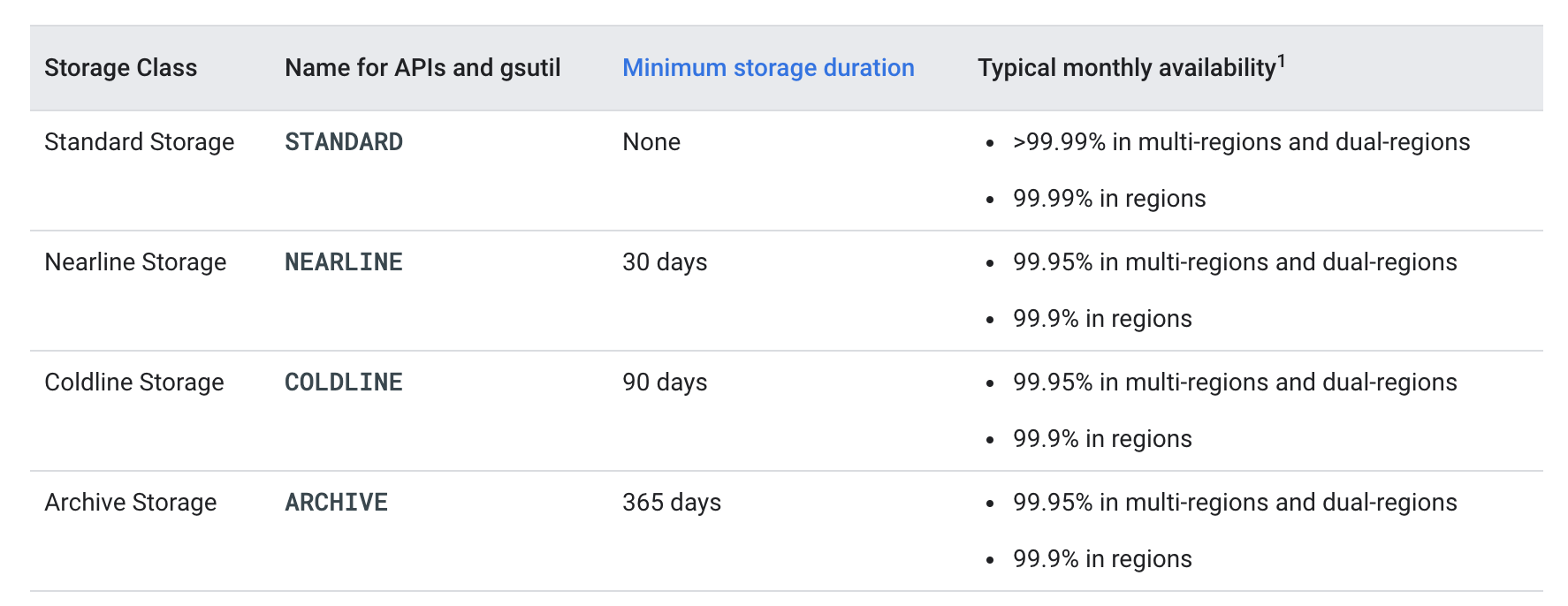Google Cloud Storage – Storage Classes
- Google Cloud Storage – Storage class affects the object’s availability and pricing model
- Storage class of an existing object can be changed either by rewriting the object or by using Object Lifecycle Management.
- Bucket’s default storage class is set to Standard Storage, if not specified
- A default storage class for the bucket can be specified so when a bucket is created, all the objects added to the bucket will inherit this storage class unless explicitly set otherwise.
- Changing the default storage class of a bucket does not affect any of the objects that already exist in the bucket.
Storage Classes Options
- All storage classes provide the following
- Unlimited storage with no minimum object size.
- Worldwide accessibility and worldwide storage locations.
- Low latency (time to the first byte typically tens of milliseconds).
- High durability (99.999999999% annual durability).
- Geo-redundancy, if the data is stored in a multi-region or dual-region.
- A uniform experience with Cloud Storage features, security, tools, and APIs
Standard Storage
- Standard Storage is best for data that is frequently accessed (hot data) and/or stored for only brief periods of time.
- for regional locations
- for dual-region,
- provides optimized performance when accessing Google Cloud products that are located in one of the associated regions,
- provides improved availability that comes from storing data in geographically separate locations.
- Availability SLA > 99.99%
- for multi-region
- ideal for storing data that is accessed around the world, such as serving website content, streaming videos, executing interactive workloads, or serving data supporting mobile and gaming applications.
- Availability SLA > 99.99%
Nearline Storage
- Nearline Storage is a low-cost, highly durable storage service for storing infrequently accessed data (warm data)
- Nearline Storage is a better choice than Standard Storage in scenarios where slightly lower availability, a 30-day minimum storage duration, and data access costs are acceptable trade-offs for lowered at-rest storage cost
- Nearline Storage is ideal for data you plan to read or modify on average once per month or less. for e.g., if you want to continuously add files to Cloud Storage and plan to access those files once a month for analysis, Nearline Storage is a great choice.
- Nearline Storage is also appropriate for data backup, long-tail multimedia content, and data archiving.
Coldline Storage
- Coldline Storage provides a very-low-cost, highly durable storage service for storing infrequently accessed data (cold data)
- Coldline Storage is a better choice than Standard Storage or Nearline Storage in scenarios where slightly lower availability, a 90-day minimum storage duration, and higher costs for data access are acceptable trade-offs for lowered at-rest storage costs.
- Coldline Storage is ideal for data you plan to read or modify at most once a quarter.
Archive Storage
- Archive Storage is the lowest-cost, highly durable storage service for data archiving, online backup, and disaster recovery. (coldest data)
- Archive Storage has no availability SLA, though the typical availability is comparable to Nearline Storage and Coldline Storage.
- Data is available within milliseconds, not hours or days.
- Archive Storage has higher costs for data access and operations, as well as a 365-day minimum storage duration.
- Archive Storage is the best choice for data that you plan to access less than once a year. for e.g. cold data storage for archival and disaster recovery

Legacy Storage Classes
- Google Cloud Storage provided additional storage classes which have been phased out
- Multi-Regional Storage
- Equivalent to Standard Storage, except Multi-Regional Storage can only be used for objects stored in multi-regions or dual-regions.
- Regional Storage
- Equivalent to Standard Storage, except Regional Storage, can only be used for objects stored in regions.
- Durable Reduced Availability (DRA) Storage:
- Similar to Standard Storage except:
- DRA has higher pricing for operations.
- DRA has lower performance, particularly in terms of availability (DRA has a 99% availability SLA).
- Similar to Standard Storage except:
- Multi-Regional Storage
GCP Certification Exam Practice Questions
- Questions are collected from Internet and the answers are marked as per my knowledge and understanding (which might differ with yours).
- GCP services are updated everyday and both the answers and questions might be outdated soon, so research accordingly.
- GCP exam questions are not updated to keep up the pace with GCP updates, so even if the underlying feature has changed the question might not be updated
- Open to further feedback, discussion and correction.
- You’ve created a bucket to store some data archives for compliance. The data isn’t likely to need to be viewed. However, you need to store it for at least 7 years. What is the best default storage class?
- Multi-regional
- Coldline
- Regional
- Nearline